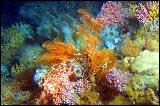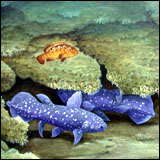SAEON Elwandle Node: A phased approach for the future
|
Dr Angus Paterson, Manager of the SAEON Elwandle Node, is a busy man. Since his appointment on 1 June last year, he has been exploring his new mandate and meeting with individuals from current and potential SAEON stakeholder institutions.
These include Marine and Coastal Management (MCM), the Department of Water Affairs and Forestry (DWAF), the Water Research Commission (WRC), the University of Cape Town (UCT), the Nelson Mandela Metropolitan University (NMMU), Rhodes University, the Council for Scientific and Industrial Research (CSIR), the African Coelacanth Ecosystem Programme (ACEP), Oceanographic Research Institute (ORI) & the South African Institute for Aquatic Biodiversity (SAIAB).
He has also been studying relevant literature including various Coastal-GOOS (Global Ocean Observation System) documents as well as the original document commissioned by SAEON, entitled "The Development of Marine and Coastal Nodes for the South African Environmental Observation Network". The SANCOR (SA Network for Coastal and Oceanic Research) Steering Committee endorsed a consultative process with relevant regional SANCOR forums to produce a balanced proposal for the node that has the support of the marine science community at large. SANCOR is the representative coordinating body of marine science in South Africa.The document outlines the broader mandate of SAEON and a significant number of tasks that the node should be responsible for. In short, the report recommends that SAEON be involved in four major areas:
-
Data collection - covering data collection on coastal dunes, estuaries, rocky intertidal zones and rocky reef in all three coastal Bioregions within South Africa
-
Data management (archiving and dissemination)
-
Analysis and reporting (including modelling)
-
Education outreach
SAEON Elwandle Node concept document
Based on his findings, Angus is currently in the process of conceptualising the strategic and management approach for the node, and has drafted an initial concept document outlining the approach to establish the SAEON Elwandle Node as a fully functioning SAEON operation. The role that the SAEON Elwandle Node will be playing is extensive and the strategy thus needs to be implemented in a phased manner.
In the proposed approach to the SAEON Elwandle Node roll out, a number of considerations are important:
-
The initial staff complement should be limited to the node manager, database manager, education outreach officer and monitors
-
A national approach must be adopted
-
The approach for the SAEON Elwandle Node business plan should reflect the broader spirit of that envisaged by SANCOR/SAEON.
Elwandle thrust roll out
While the Node Manager is ultimately responsible for the roll out of all the thrusts, many of them require specialist skills and their planning and initiation is dependent on the appointment of the required manager.
Elwandle will have four main thrusts for which the following key staff will be responsible:
-
Monitoring data collection - Node manager
-
Data management - Database manager
-
Primary analysis - Node manager & database manager
-
Education outreach - Education outreach officer
The emphasis in the concept plan is on the roll out of monitoring and capacity building, followed by data management. Outreach and primary analysis require further discussions with a range of stakeholders.
Bioregion approach
The concept approach recommends that different core sites be set up in the different Bioregions (as per the SANCOR document). These different Bioregions will be addressed in a phased manner according to financial and logistical considerations.
-
Phase 1 - Agulhas Bioregion (warm temperate region)
-
Phase 2 - Subtropical East Coast & Cool Temperate West Coast Bioregions
The rationale behind prioritising the Agulhas Bioregion is that the Bioregion (Southern and Eastern Cape) at present has very few monitoring activities. The Bioregion also has the highest number of estuaries along the coastline which are a key facet of SAEON's coastal node and very susceptible to long-term change. Lastly, no emphasis was placed on undertaking baseline research on any habitat in the former Transkei and Ciskei regions during the apartheid years and thus there is a paucity of LTER (Long-Term Ecological Research) data for the region. This is further complicated by high subsistence use of the coastal zone in this Bioregion.
SAEON's core and affiliated sites concept in relation to the Agulhas
Bioregion
The core site concept provides an opportunity to focus LTER and monitoring on specific areas so that continuity in data can be assured. Within the Agulhas Bioregion there is a number of possible core and affiliated sites.
Preliminary discussions have indicated that Algoa Bay could be a good choice as a core site as the Bay -
- has the full range of habitat types that SAEON should monitor, namely rocky intertidal, sandy beaches, coastal dunes, estuaries, offshore islands and reef;
- has a number of anthropomorphic stressors, namely large municipal areas, two harbours and an active fishing industry; and
- will have a large Marine Protected Area (Greater Addo National Park) covering almost half of the area.
All of the above characteristics allow for good, comparative, issues-driven LTER. Furthermore Rhodes, NMMU, Fort Hare and Bayworld are either within the bay area or in close proximity. This will allow for effective platform initiation and management through research supervision and equipment/manpower sharing.
In terms of affiliated sites, the Bioregion has numerous estuaries and near-shore phenomena such as the Port Alfred Upwelling Cell, Waterfall Bluff near Port St Johns, cold ridge and wind-driven upwelling areas (Tsitsikamma & St Francis) which could be excellent affiliated sites. All of the above features offer interesting LTER and monitoring opportunities.
Some of the initial suggestions from the scientific community include:
- Kleinemonde Estuary LTERM (LTER Monitoring) site - the Kleinemonde estuary has a unique eleven-year biodiversity fish data series which has tracked the change in biodiversity patterns over long temporal periods
- Mngazana Estuary LTERM site - the estuary has a detailed 4-year data series, is at the edge of the Bioregion and is probably one of the best understood Transkei estuaries
- Tsitsikamma National Park LTERM site - the park is the largest and oldest "no take" park in South Africa and has excellent baseline data sets for abiotic and biotic data. There are numerous possible LTER and monitoring opportunities looking at long-term trends in fish recruitment, population dynamics and ecosystem productivity
- Coastal Upwelling LTERM site - discussions with Mike Roberts of MCM indicate that they are currently looking at various upwelling features along the Bioregion and that a SAEON platform observing various biotic parameters would be highly beneficial.
The final choice of the Agulhas Bioregion core site and affiliated sites will be undertaken jointly by SAEON and a number of high-profile scientists working in the region during a workshop scheduled for early this year.
Monitors/Students
The initial SANCOR/SAEON document produced in 2005 discusses the use of monitors, and proposes that these monitors have at least a BSc Hons degree. In light of the chronic shortage of young scientists (in particular black scientists) entering the system, it is recommended that the monitors use the data that they collect for MSc degrees.
The opportunity of combining the monitoring roles into a cyclical capacity building exercise is strongly recommended. The supervision of the student monitors by scientists will also allow for immediate use of the research platform provided by SAEON.
The cyclical nature of the MSc/Monitor positions may have the potential to impact on institutional memory and quality control in terms of standards used in data collection and analysis. One of the major issues raised in the US LTER All Scientists meeting in 2006 was quality control in long-term data series.
In order to prevent any issues that may arise in terms of continuity in data collection and analysis, the following activities will take place:
- Intensive taxonomic training will be provided to each set of students. This will include a practical exam for all students prior to them being allowed to work on SAEON samples
- A reference collection of all types of marine invertebrates will be built up for comparative purposes
- A quality control system of duplicate samples and regular competency testing will be implemented
Data management and archiving
The sourcing, collation, archiving and dissemination of long-term data series will be a priority area of the SAEON Elwandle Node. The need for a consolidated searchable data repository for abiotic and biotic data for the coastal region is vital and the development of this thrust will be the key priority of the database manager who should be appointed early in 2007. A survey of currently available databases and data sets will be undertaken in 2007.
In short, the SAEON Elwandle Node is progressing rapidly with staff advertisements going out in quick succession. A fully fledged and fully functioning node is expected in 2007.
Related content
- SAEON Elwandle joins forces with SAIAB, SANParks and Rhodes
- SAEON Elwandle appoints first doctoral candidate





